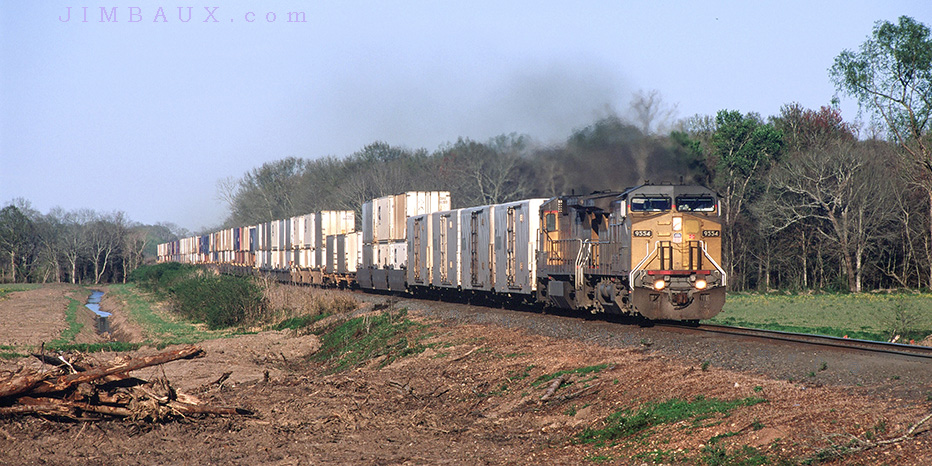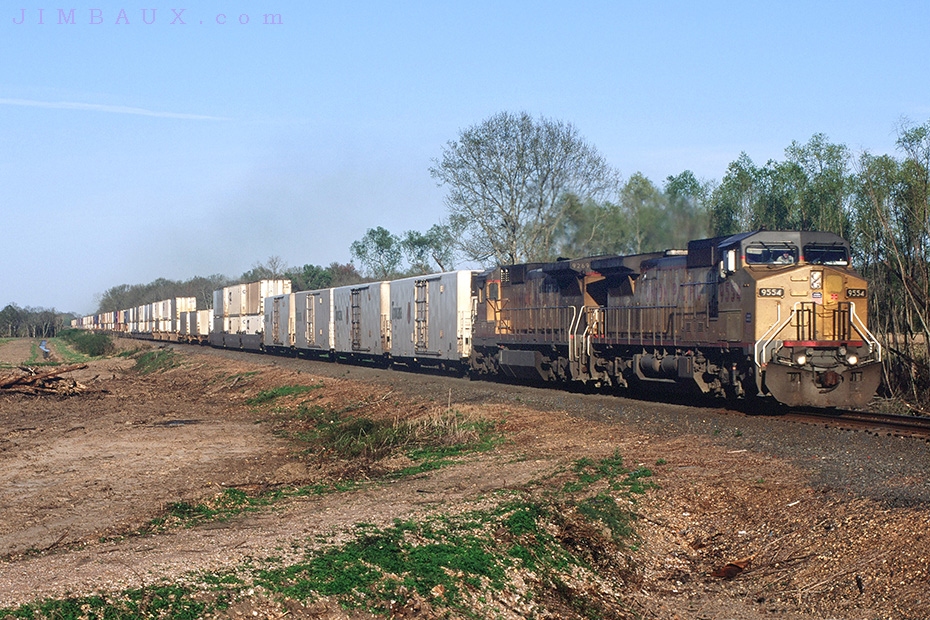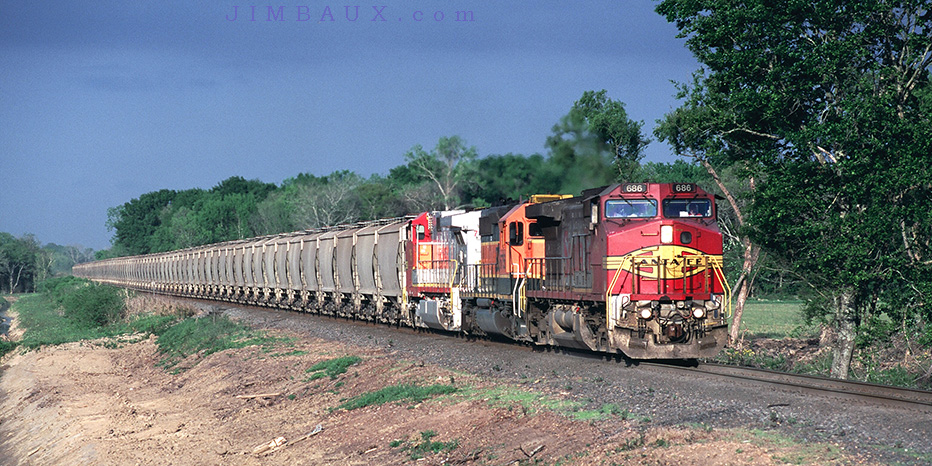In March of 2014, I published here on Jimbaux’s Journal images of scanned 35-milimeter film slides that I had taken as photographs 10 years to the day after I had taken the pictures.
A few of my presentable already-then-scanned images from March of 2004 didn’t make it into blog posts at that time, and I will not only remedy that here but also maintain the continuity of images by just including links to the already-published posts of March 2004 pictures at the appropriate parts in the chronological description.
Robbed By Privatization
The only thing that I will say before I get to the pictures themselves is a reiteration of an explanation about the significance of the location known as Thibodaux Junction, where many of my March 2004 images were made, and its personal relevance for me.
Thibodaux Junction was, only briefly, a great place to photograph trains. It is – or was – called Thibodaux Junction because it is where the branch to Thibodaux, from which there soon was another branch to Napoleonville (to the point that, eventually, SP called the whole thing “the Napoleonville Branch”), diverged from the mainline, but the branch actually diverged from the siding; however, there was once a wye there, the western leg of which was the beginning of the branch, with the eastern leg long gone.
A few years prior to these pictures being made, the Acadia Road crossing was surrounded by trees, which greatly limited photography possibilities, but at least it was still publicly accessible – unlike today. A then-public gravel road known as Acadia Road (an extension of the paved road in Thibodaux of the same name) crossed the track at Thibodaux Junction.
The subsequent – and, when this picture was made, ongoing – clearing of the trees by the track on either side of the Acadia Road crossing really opened up some great picture possibilities, and I took advantage of these opportunities in the early aughts.
However, it seems the reason for the clearing of trees was also or, at least, was related to the reason that, a little bit more than a year later, I would no longer be able to access this area at all. Local farmers were expanding the fields. The land where the trees were is now sugarcane fields, and Lafourche Parish eventually ceded Acadia Road to the farmers in that area, to my great despair, ending access to what was one of the greatest photo locations for trains for many around.
One reason that this was such a great area for photographing trains is that it was a good shot from either side of the track; that is rare, because, usually, an automobile-road crossing that is a good photo location is a good photo location from only one side of the track.
The pictures of westbound trains at Thibodaux Junction in this essay (and in the links to the March 2004 blog posts published in 2014) are from the northern side of the track looking to the east of a westbound train, while, earlier in the year, the same road north of the track was a good late-afternoon location for westbound train pictures, as seen in examples in both the “January 2004 Images” essay and the “February 2004 Images” essay.
The tree clearing at this time also opened up photo possibilities looking to the west (of approaching eastbound trains), especially from the southern side of the track, too. That’s why it was such a valuable place for me then.
With all of that in mind, here are the pictures.
Saturday, The 6th
At 16:15 on this day, Union Pacific Railroad train LLS51, The Chip Local, passed eastbound through Schriever with one locomotive, UP 493, a patched Southern Pacific locomotive, and 10 cars. It met UP train IATCI – Intermodal, Atlanta, Georgia, to City Of Industry, California – at Raceland.
At 17:00, about a dozen miles west of the west siding switch at Raceland, the IATCI came into view at Thibodaux Junction.
Look at the conductor! He seemed really amused and leaned toward the engineer’s-side windshield to wave and-or point at me!
In that second image, you can see the remains of the roadbed of the wye that the farmers were obliterating.
Sunday, The 7th
On this day, I was back at Thibodaux Junction and got some much better pictures.
Wednesday, The 10th
Guess where I am on this afternoon!
I am back at Thibodaux Junction!
Do you see how important this location was to me? Do you understand how sad and indignant I felt when it got robbed from me? Do you see how I was radicalized?
Thursday, The 25th
On this day, we see one of my most memorable pictures, as it is of a scene that includes many elements of the past that are not with us today, one that I have already discussed and that seems to be a theme of this article.
I love this picture; it’s one my favorites, and the storm-lighting really helps to make it special for me, but there are several other reasons too, as I will describe here and as I have already described.
On my way home from work on Thursday 25 March 2004, I was aroused by the mention on the Lafayette Subdivision radio of an “ATSF 686 west” at milepost 33. Even at that date, a train led by a locomotive with Santa Fe reporting marks was becoming very rare, and it had been a long time since I had seen a Warbonnet on the point of a train. So, I reversed course to go and catch this train!
You will recognize the location!
The sun was on the ragged edge of a cloud, and fortune was on my side as the headlight popped into view. To my delight, this turned out to be the fly ash train, and I think that this was the only decent photograph that I ever got of the fly ash train, a train that ceased to run at about the time of the Great Recession.
As I had feared, the 686 was a bit faded and-or dirty, as were most of the Superfleet locomotives by this time, sadly. However, the 715 – the third locomotive – was still shiny. I sure wish it would have been leading. Oh well. The train had 350 axles and had MBKX hopper cars.
Again, do you recognize the location?
Anyway, the “fly ash train” as it was known was a unit train that made its way via BNSF through southern Louisiana every week or so from a coal-fired power plant in Martin Lake, Texas, to a cinder block manufacturer in Florida on the CSX. “Fly ash” is simply the residue from the process of burning coal. On the BNSF, the eastbound loaded train was the U-MARNWO (Unit train, Martin Lake, Texas, to New Orleans), and the westbound empty train was the U-NWOMAR. I don’t know what the CSX symbols were. Before the train started using these more modern MBKX hopper cars, there was at least one trainset of old Rock Island hopper cars, which I thought really neat, with the big “Rock Island” lettering still on the side.
So, there is plenty about this picture that is no longer with us: the fly-ash train itself, ATSF locomotives, Warbonnets, and the location itself. Compare this picture to the one that I took 10 years to the day later. Yes, now we have different locomotives, different paint schemes, and a new (for this area, at least, but for many others too) kind of unit train.
There is something else different about this picture: film. I love the colors of this picture. It was taken on Fujichrome Velvia 50, a film noted for its color saturation, though colors in this shot have plenty to do with the storm lighting (as I mentioned earlier, clouds had just passed overhead, and they can obviously be seen in the background.)
Sunday, The 28th
This was a very brief Sunday Sermon, and it’s a good example of the westward view – of an approaching eastbound train – at Thibodaux Junction, as, at 08:10, I photographed BNSF Railway train H-GATNWO (Galveston, Texas, to New Orleans, Louisiana) here after it had stopped to set out one car.
Notice the equipment clearing the land that had recently been trees.
Wednesday, The 31st
The pictures made on this day are the only pictures presented here that were not taken at Thibodaux Junction!
On this day, this last day of the month, I finished off the aforementioned roll of Fujichrome Velvia 50 when I photographed a one-car train on my beloved Lockport Branch that, to no one’s surprise and to my great dismay, closed five years later.
That is all.
Jim





